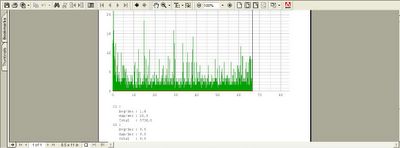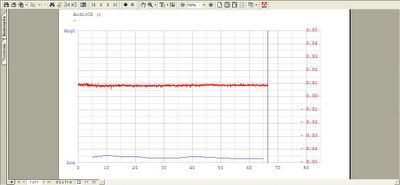Perfect Sound Forever? This was Sony's marketing slogan for CD way back in 1982.
PERFECT SOUND FOREVER MY A$$!
The Pink Floyd Division Bell that I recently purchaced sounds absolutely FANTASTIC. Much better than the copy that I checked out from the library recently. Neither of them are remasters so there is little reason for this to be the case. But as I have hinted at recently digital isn't perfect as most would have you believe. Here comes a bold statement: Different pressings of the same CD from the SAME digital master sound DIFFERENT.
I believe that it has to do with digital jitter inherent in the CD manufacturing process. As mentioned in an earlier post Robert Harley in his book "The Complete Guide to High-End Audio" defines digital jitter as follows: "Timing variations in the clock that synchronizes events in a digital audio system. The clock could be in an analog-to-digital converter that controls when each audio sample is taken. Of more interest to audiophile is clock jitter in digital audio reproduction; the clock controls the timing of the reconstruction of digital audio samples into an analog signal. Jitter degrades musical fidelity."
In short all the ones and zeros are right but the clock that tells the digital to analog converter in a CD player WHEN to decode them is wrong. An interesting side effect is that if you choose good CD-R media and burn at the right speed your copy will have lower jitter because the CD burner in computers doesn't copy the original flawed word clock. The pits on the CD will also be more uniform in size than a mass manufactured CD, further reducing digital jitter. All of this can be measured, so I'm not NUTS. Well maybe I am but not because any of this, although all of this maybe driving me in that direction. One could make the argument that none of this is audible, but I can hear it easily on my system. Stand alone burners for music have none of these benefits because they copy this flawed clock information. In short the burned copy will sound BETTER than the original. FUCK time to burn my entire collection of CDs. I'm going to be very busy. Talk to all of you in a decade or so.
I should probably just watch "Austin Powers: Goldmember" and try to forget about all of this for a while. WAIT! From which pressing plant did this copy come? What is the plot of E1, E2, and E3 errors. What does the jitter spectrum analysis look like?
Below are four graphs that address my favorite topic of digital jitter and the possibility of a digital copy being either better or worse than the original. Four record speeds were checked 4x, 10x, and 16x. 24x was not tested as this speed introduces audible distortion. For the sake of the sanity of everyone involved I only posted the jitter and error rate graphs for the original and 10x. 10x had significantly lower jitter and a lower error rate as well. Why are errors on the original NOT present on the copy? Simple a CD-Rom in a computer will read data many more times than a CD player. On one of those passes it will most likely recover the data, a CD player will simply give up and resort to it's error correction algorithm. Tomorrow Chris will bring me all four copies and I will listen to see what audible effect all of this has. I know that in a true scientific test I would have done the listening before Chris did his analysis but time simply didn't allow this to occur. You can click on each graph to see it in more detail. Please do not take these results as universal. The results are dependent on the CD-ROM drive and the way that it interacts with the media chosen.
10X Error Graph
Here is the 10x speed graph. The C1 average errors per second average to 0.4 per second with a maximum of 10 per second. Total errors of 1656
Original Error Graph
Here is the error rate of the original. The average error rate per second is 1.4 with a maximum error rate of 25.0 per second for a total of 5736.
Jitter of 10X
This is a copy done at 10x speed. Notice how much closer the line tracks the 0.0 line and how much less jagged it is.
Jitter of Original
This is the jitter of the original CD. The Closer to the 0.0 the red line is the better. The flatter the red line is the better. This CD red line is closer to the 0.01 line than the 0.00 line and is pretty jagged.
I believe that it has to do with digital jitter inherent in the CD manufacturing process. As mentioned in an earlier post Robert Harley in his book "The Complete Guide to High-End Audio" defines digital jitter as follows: "Timing variations in the clock that synchronizes events in a digital audio system. The clock could be in an analog-to-digital converter that controls when each audio sample is taken. Of more interest to audiophile is clock jitter in digital audio reproduction; the clock controls the timing of the reconstruction of digital audio samples into an analog signal. Jitter degrades musical fidelity."
In short all the ones and zeros are right but the clock that tells the digital to analog converter in a CD player WHEN to decode them is wrong. An interesting side effect is that if you choose good CD-R media and burn at the right speed your copy will have lower jitter because the CD burner in computers doesn't copy the original flawed word clock. The pits on the CD will also be more uniform in size than a mass manufactured CD, further reducing digital jitter. All of this can be measured, so I'm not NUTS. Well maybe I am but not because any of this, although all of this maybe driving me in that direction. One could make the argument that none of this is audible, but I can hear it easily on my system. Stand alone burners for music have none of these benefits because they copy this flawed clock information. In short the burned copy will sound BETTER than the original. FUCK time to burn my entire collection of CDs. I'm going to be very busy. Talk to all of you in a decade or so.
I should probably just watch "Austin Powers: Goldmember" and try to forget about all of this for a while. WAIT! From which pressing plant did this copy come? What is the plot of E1, E2, and E3 errors. What does the jitter spectrum analysis look like?
Below are four graphs that address my favorite topic of digital jitter and the possibility of a digital copy being either better or worse than the original. Four record speeds were checked 4x, 10x, and 16x. 24x was not tested as this speed introduces audible distortion. For the sake of the sanity of everyone involved I only posted the jitter and error rate graphs for the original and 10x. 10x had significantly lower jitter and a lower error rate as well. Why are errors on the original NOT present on the copy? Simple a CD-Rom in a computer will read data many more times than a CD player. On one of those passes it will most likely recover the data, a CD player will simply give up and resort to it's error correction algorithm. Tomorrow Chris will bring me all four copies and I will listen to see what audible effect all of this has. I know that in a true scientific test I would have done the listening before Chris did his analysis but time simply didn't allow this to occur. You can click on each graph to see it in more detail. Please do not take these results as universal. The results are dependent on the CD-ROM drive and the way that it interacts with the media chosen.
10X Error Graph
Here is the 10x speed graph. The C1 average errors per second average to 0.4 per second with a maximum of 10 per second. Total errors of 1656
Original Error Graph
Here is the error rate of the original. The average error rate per second is 1.4 with a maximum error rate of 25.0 per second for a total of 5736.
Jitter of 10X
This is a copy done at 10x speed. Notice how much closer the line tracks the 0.0 line and how much less jagged it is.
Jitter of Original
This is the jitter of the original CD. The Closer to the 0.0 the red line is the better. The flatter the red line is the better. This CD red line is closer to the 0.01 line than the 0.00 line and is pretty jagged.




No comments:
Post a Comment